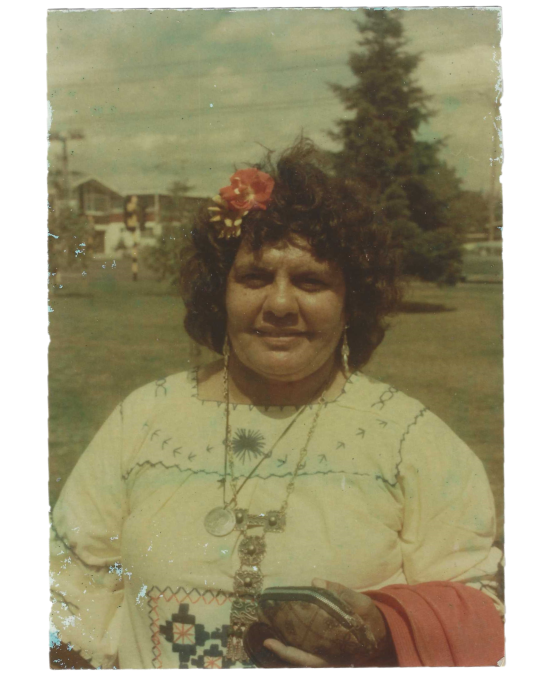
Aboriginal welfare officer advocates for community
As well as working with communities on government-run reserves in the Northern Territory, Vai Stanton Mimbinggal worked with the government to improve conditions for Aboriginal people nationally.
They were the things I brought up to Social Security. Now, we got some people qualifying for pensions or for benefits … They were eligible, but nobody did anything about it
Photograph supplied: family collection.
| Attachment | Size |
|---|---|
| interview-with-vai-stanton-plaintext_0.docx | 50.7 KB |
In the 1960s and 1970s, Violet (Vai) McGinness Stanton Mimbinggal worked for better conditions for Aboriginal people. Stanton was a Kungarakany and Gurindji woman.
In this extract from a 1991 oral history about her life, she talks about her experiences working in welfare and advising the government.
Welfare work at Bagot
In 1964, Stanton began her work as a Welfare Officer at Bagot, a government reserve in Darwin. She talks about the poor conditions people were living in. For example, she remembers a man doing manual work for what was called a ‘training allowance’ even though he was older and had a disability.
Stanton talks about how the reserve managers violated Aboriginal people’s privacy and took their government payments. She says the officials opened everyone’s mail, which included social security cheques, and the administrator took rent out of people’s payments before passing the rest on.
Stanton reflects that most people were used to being treated this way based on their experiences living at the reserve. She remembered explaining to Bagot community members that this wasn’t acceptable.
She says she encouraged several people to act together and to insist they open their own mail when it came. People then had to fight to be able to cash their own cheques because they hadn’t been stamped by the reserve superintendent. Stanton had to defend the right of Bagot residents to endorse their own cheques by signing their name or using a thumbprint.
Stanton recalled:
That was the very beginning where the people took a stand against that administrative office … What the outcome of that was, well those people’s mail weren’t opened – none of them.
Advising the Department of Social Security (DSS)
Stanton was determined to make change for the community. In the 1970s, she was invited to be part of the Advisory Council on Social Security and Welfare for Bill Hayden, Minister for Social Security.
In this role, she drew attention to the issues Aboriginal people were facing. She especially focused on problems she felt the government wasn’t fixing.
One of these issues was Aboriginal people missing out on Old-age Pension because they couldn’t prove their age. She had seen this happen to people she worked with, for example those who didn’t have a birth certificate. Stanton came up with other ways for Aboriginal people to prove their age and work out their birthdates.
To make sure DSS processes accounted for these types of issues, Stanton helped DSS rewrite their servicing manual. ‘Social Security in Canberra were very interested in my opinions as an Aboriginal member,’ she said. ‘As they were upgrading the manuals, they made me feel an important part of that team.’
Stanton’s interview shows the changes in how Aboriginal people interacted with DSS and payments around this time. It also shows the increasing involvement of Aboriginal people in impacting DSS decision making.
Vai McGinness Stanton Mimbinggal was a community and welfare worker. She worked at Bagot from 1962 to 1974. She was born in 1929, the daughter of activist and North Australian Workers’ Union leader Jack McGinness and Violet Wakelin. Stanton’s uncle, Joe McGinness, was also an activist and excerpts from his autobiography are included in this collection.
The original recording and full transcript of Vai Stanton Mimbinggal’s oral history is held in Library & Archives NT. The excerpt here was supplied by the Northern Territory Archives Service.
Copies of Northern Perspective, in which excerpts from the oral history were published, are held in AIATSIS’s collection.
Permissions
Permissions to include this excerpt of Vai Stanton Mimbinggal’s oral history were provided by her daughters Dr Sue Stanton, Kez Hall, Lynne Stanton, and Rena Stanton Laniyuk.
The portrait photograph of Vai Stanton Mimbinggal was kindly shared from the family’s collection.
Permission was provided by the interviewer Martin Kamener.
Consultation was also undertaken with representative of the Bagot community, Helen Fejo-Frith.
Citations
Attributed to Mabo KE (1976) Rotorua, New Zealand [Aotearoa] 1976 Aboriginal Arts Board - South Pacific Festival [photo taken by Eddie ‘Koiki’ Mabo] [photograph], Stanton/Hall family collection, supplied.
Stanton V and Kamener M (1991) Preservation recording of oral history interview with Vai Stanton, 1991, NTRS 3164, Electronic preservation recordings of oral history interview 2005 – onwards, BWF 1202, Northern Territory Archives Service, Library & Archives NT.
